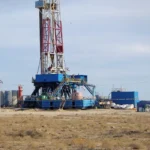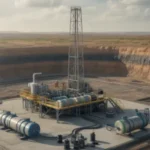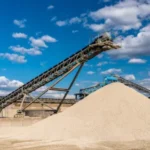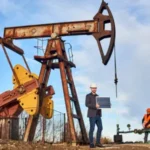The Essential Guide to Clay Stabilizers in the Oil and Gas Industry

Clay stabilizers are a crucial category of chemical additives in the oil and gas industry. They are made to combat the detrimental effects of clay minerals on well productivity. These additives prevent clay swelling and fines migration, which can otherwise lead to a dramatic reduction in reservoir permeability and costly wellbore damage. This comprehensive guide explores the fundamental principles, types, applications and future trends of clay stabilizers, highlighting their pivotal role in modern oil and gas operations.
What Are Clay Stabilizers?
Clay stabilizers are chemical compounds added to drilling, completion, and stimulation fluids to control the behavior of naturally occurring clay minerals in reservoir rock. Clays like smectite, illite, and kaolinite can react with water-based fluids, causing them to swell, disperse, and migrate within the formation’s pore network.
This can create blockages that severely restrict the flow of oil and gas. Clay stabilizers work by chemically or physically interacting with the clay surfaces to prevent these adverse reactions, thereby preserving the integrity of the reservoir and maintaining fluid flow paths.
The Critical Need for Clay Stabilization
Without effective clay stabilization, the interaction between drilling or fracturing fluids and reservoir clays can lead to significant problems:
- Formation Damage: The swelling of clays can reduce the pore throat size, drastically cutting the rock’s permeability. Some studies suggest a permeability reduction of up to 70% can occur, which severely hinders hydrocarbon production.
- Fines Migration: Even non-swelling clays, such as kaolinite, can be dislodged and carried along with the fluid flow. These tiny particles, often less than 4 microns, can get trapped in narrow pore spaces or proppant packs, causing blockages and impairing the effectiveness of hydraulic fractures.
- Reduced Well Productivity: Ultimately, formation damage and fines migration lead to inefficient hydrocarbon flow, lower production rates, and a shorter productive life for the well. This often necessitates expensive remedial treatments like acidizing or refracturing.
Common Clay Minerals in Oil and Gas Reservoirs
Different clay minerals exhibit varying degrees of water sensitivity and structural characteristics:
- Smectite (Montmorillonite): This is the most problematic clay mineral due to its high swelling capacity. Its layered structure allows water molecules to enter between the platelets, causing a significant increase in volume.
- Illite: Possesses a moderate swelling potential. While its layered structure is more stable than smectite’s, illite can still swell and release fines under certain conditions.
- Kaolinite: Although it has a very low swelling potential, kaolinite is the most common source of fines migration. Its small, book-like particles are easily dislodged and transported by fluid flow, leading to pore throat blockages.
These minute platelets of clay, which stack to form larger layers, are pervasive in sedimentary rocks such as shale and siltstone, making clay stabilization a necessary consideration in most drilling and completion projects.
How Clay Stabilizers Work: The Core Mechanisms
Clay stabilizers operate primarily through two key mechanisms to prevent formation damage:
1. Ion Exchange
Clay minerals typically have a net negative surface charge. In their natural state, this charge is balanced by cations, most commonly sodium ions (Na+), within the formation water. When low-salinity water-based fluids are introduced, a concentration gradient is created. The native sodium ions in the clay are exchanged with cations from the injected fluid, which can cause the clay structure to swell and disperse. Clay stabilizers, particularly inorganic salts like Potassium Chloride (KCl), provide a high concentration of specific cations (K+) that are a more suitable fit for the clay structure. These ions replace the native sodium ions, stabilizing the clay and preventing water absorption.
2. Surface Chemistry Modification
Organic and polymeric stabilizers, such as quaternary amines and cationic polymers, work by neutralizing the negative surface charge of the clay particles. These chemicals are positively charged and adsorb onto the negatively charged clay surfaces. This neutralization prevents the electrostatic repulsion between clay particles that would otherwise cause them to disperse and migrate. This mechanism provides a more permanent form of stabilization compared to simple ion exchange.
Types of Clay Stabilizers and Their Comparative Effectiveness
The choice of clay stabilizer depends on the specific reservoir conditions, operational requirements, and environmental considerations. The primary types include:
1. Inorganic Salts
Potassium Chloride (KCl): For decades, KCl has been the industry-standard clay stabilizer due to its low cost and effectiveness. It works by providing potassium ions (K+), which are similar in size to the vacant spaces in the clay lattice, preventing swelling. However, KCl typically requires high concentrations (often >3% by volume) and can contribute to environmental concerns due to the high chloride load in produced water.
2. Organic Stabilizers
Choline Chloride: A modern, more environmentally friendly alternative to KCl. Choline chloride is effective at much lower concentrations (typically 1–2%), significantly reducing the environmental chloride load—by as much as 75%—and is biodegradable. Its effectiveness and lower environmental impact have made it a favored choice for many operators.
3. Polymeric Stabilizers
Cationic Polymers and Quaternary Amines: These are long-chain molecules that provide long-term stabilization. They adsorb onto the clay surfaces, effectively “locking” the clay particles in place and preventing both swelling and fines migration. Compounds like TMAC (tetramethylammonium chloride) and other proprietary formulations are used for their robust and lasting effects.
4. Nanotechnology-Based Additives
This is a growing area of innovation. Nanoscale particles are being developed to offer improved performance with minimal environmental footprint. These stabilizers can penetrate smaller pores and provide a more uniform, and durable, protective layer on the clay surfaces.
Application in Hydraulic Fracturing
Hydraulic fracturing, a process that uses high-pressure fluid to create fissures in the reservoir rock, is a prime application for clay stabilizers. The fracturing fluid, which is often water-based, can trigger severe clay swelling and fines migration. By incorporating clay stabilizers into the fluid blend, operators ensure that the newly created fracture network remains conductive and a clear path for proppant to enter and for hydrocarbons to flow out is maintained. Without this protection, the integrity of the fracture could be compromised, leading to a rapid decline in production.
Market Dynamics and Key Industry Players
The global clay stabilizer market is a significant segment of the oilfield chemicals industry. Valued at USD 464.8 million in 2023, it is projected to grow to USD 834.25 million by 2030, with a CAGR of 7.3%. This growth is driven by increasing global energy demand and the need for enhanced oil recovery techniques in unconventional plays.
Major players in this market include:
- Halliburton
- Schlumberger
- BASF
- Dow Chemicals
- NorthStar Fluid Solutions
- SACHEM Inc.
These companies are continuously investing in research and development to create more effective and sustainable products.
Safety, Sustainability and Regulatory Trends
The oil and gas industry is facing increasing pressure to adopt more environmentally responsible practices. This has led to a major shift in the development of clay stabilizers. Modern formulations are designed to be non-toxic, biodegradable, and low in harmful components like chlorides. Regulators, particularly in regions like the United States and Europe, are increasingly mandating the use of eco-friendly chemicals to minimize the environmental impact of drilling and production activities. This trend favors products like choline chloride, which offer superior performance with a reduced ecological footprint.
Selecting the Right Clay Stabilizer
Choosing an appropriate clay stabilizer is a critical step in well planning. The selection process must consider several key factors:
- Reservoir Mineralogy: A detailed analysis of the reservoir rock’s clay content and type is essential. Different clays require different stabilizing mechanisms.
- Fluid Composition and Salinity: The compatibility of the stabilizer with the other components of the drilling, completion, or fracturing fluid is paramount.
- Performance Requirements: Is temporary stabilization during a specific operation needed, or is long-term, permanent protection of the formation required?
- Environmental and Safety Regulations: Compliance with local and national environmental standards is non-negotiable and guides the choice of a safe, non-hazardous product.
Often, customized solutions are needed, requiring laboratory testing and field trials to optimize performance and cost for a specific well or field.
Benefits of Using Clay Stabilizers
The strategic use of clay stabilizers provides numerous benefits:
- Maximizes Hydrocarbon Recovery: By preventing permeability loss and formation damage, they ensure that a greater volume of oil and gas can be efficiently extracted from the reservoir.
- Enhances Operational Efficiency: Stabilizers reduce the need for costly and time-consuming remediation treatments.
- Protects Infrastructure: They safeguard the integrity of the wellbore and the proppant packs in hydraulic fractures, ensuring the long-term productivity of the well.
- Low Cost and High Compatibility: Compared to the potential costs of lost production and well remediation, clay stabilizers are a highly cost-effective and compatible solution.
Future Outlook
The clay stabilizer market is poised for continued innovation and growth. As the industry explores more challenging, water-sensitive unconventional reservoirs, the demand for high-performance stabilizers will increase. The focus will remain on developing more environmentally friendly, biodegradable, and nano-enhanced formulations that offer superior performance while minimizing ecological risk. Furthermore, the application of these technologies is expanding beyond oil and gas into other industries such as construction and agriculture for soil stabilization, creating new market opportunities.





